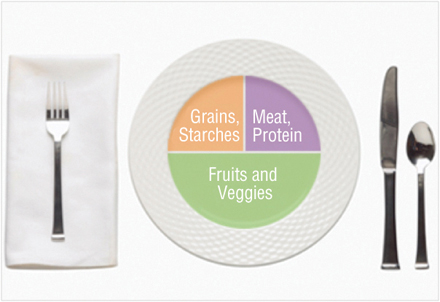Is mealtime just not the same anymore?
by Rita Barbieri, BASc., RD & Tracy Morris BA, BASc.
As we age, it is important to maintain a healthy weight. If an older person lives alone, eating enough can sometimes be a challenge. Cooking for one or two can be tough. Food may not be as interesting and may not even taste as good because we lose our ability to fully taste food as we get older. This can make it hard to maintain your weight if you don’t feel like eating.
Lack of proper nutrition affects how well we fight disease. It also limits our energy levels, preventing us from enjoying our everyday activities.
But there is good news. By simply making some wise food choices and watching portion sizes you can be on your way to a healthy weight and feeling great!
Eat a variety of healthy foods each day
Follow Canada’s Food Guide. Eating from all food groups ensures that you make wise food choices. Enjoy a variety of foods from each of the four food groups:
- Have plenty of vegetables and fruits
- Eat Protein Foods
- Choose Whole Grain Foods
- Make Water your Drink of Choice
If you are trying to gain weight, try these tips:
- Eat 3 meals a day. Include 1-2 snacks between meals.
- Add sliced fruit to yogurt or cereal.
- Add skim milk powder to prepared cream soups, hot cereals, or stews.
Healthy weight and your plate
The ‘plate method’ is a way to help you plan your meals and balance your portion sizes.
Choose an 8-inch dinner plate.
Designing your plate:

- Half of the plate should be vegetables. Aim for 2 types if you can.
- One quarter of the plate should be grain products. Include whole grains like brown rice or a whole-wheat dinner roll.
- One quarter of the plate is for lean meat or alternatives like fish or tofu.
- Enjoy with a cup of low fat milk or yogurt that is less than 2% milk fat.
- Add a piece of fruit for dessert.
Tasty snack ideas
Hungry between meals? Try these tasty snacks!
- Unsweetened apple sauce
- Low fat popcorn
- Frozen yogurt with berries
- Toast and peanut butter
- Unsalted nuts and seeds
- Veggies and a low fat dip
Tips for more enjoyable meals
Relax and enjoy each meal. Find a comfortable place to eat. Invite family or friends over. Try a new recipe, or new spices and herbs that add a little kick of flavor. Join a cooking club and learn more!
About the Authors
Rita Barbieri, BASc., RD
EatRight Ontario Contact Centre Dietitian
Tracy Morris BA, BASc.
Dietetic Intern, Sunnybrook Hospital
Click Here for print PDF file – Healthy Eating – Ismealtime just not the same anymore?
Functional foods for healthy aging
by Alison Duncan, PhD, RD
Foods that provide health benefits beyond basic nutrition are considered ‘functional’ foods. They contain ingredients that aren’t essential for growth and development, but promote optimal health.
My name is Dr. Alison Duncan, and I’m a Professor in Nutritional Science at the University of Guelph. We all know how important nutrition is for our health as we get older. Our risk for many chronic diseases increases, but functional foods can help reduce that risk.
Examples of functional foods
- Blueberries are a natural source of antioxidants, which help to prevent cancer.
- Cereal with added dietary fibre keep the bowels healthy.
- Eggs with the omega-3 fatty acids DHA and EPA are good for heart health.
New functional foods emerge from research
I focus much of my research on functional foods and their health benefits. Some of these foods are so new, they aren’t even on the market yet! For instance there’s a new spearmint tea for osteoarthritis, and soy muffins for improved heart health.
I’m part of a research team looking at bagels that are high in resistant starch. Resistant starch is a type of dietary fibre that reduces the risk of diabetes. The “Better Bagel Study” has shown that eating bagels high in resistant starch can improve how our bodies manage blood sugar.
These bagels haven’t hit the shelves yet. But you can combat diabetes with other functional foods that are high in dietary fibre:
- Breakfast cereal: Look for breakfast cereals with at least 4 grams of dietary fibre in each serving.
- Oatmeal: Still one of the best ways to start the day. For added functional food punch, mix in some blueberries, cinnamon, and walnuts!
- Whole grain bread: Choose breads made from whole grains for the most nutrition.

Want to learn more about functional foods?
I’m part of a nutrition research group called Agri-food for Healthy Aging. This is part of the Schlegel-UW Research Institute for Aging. If you’d like to learn more about research exploring functional foods for healthy aging visit the A-HA website . You’ll also find a Functional Foods for Healthy Aging Toolkit and fact sheets on common functional food ingredients, such as omega-3 fatty acids, plant sterols, and dietary fibre.
About the Author
Alison Duncan, Ph.D., R.D. is a Professor and Associate Director of Research at the Human Nutraceutical Research Unit in the Department of Human Health and Nutritional Sciences at the University of Guelph.
Click Here for print PDF file – Healthy Eating – Functional foods for healthy aging

- Categories
Recent Posts

